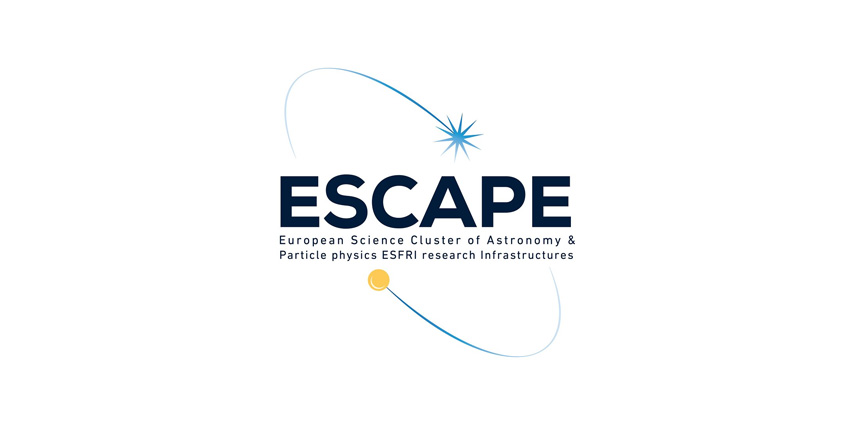European Science Cluster of Astronomy & Particle physics ESFRI research infrastructures
ESCAPE (European Science Cluster of Astronomy & Particle physics ESFRI research infrastructures. ID SEP-210506816) aims to address the Open Science challenges shared by ESFRI facilities (SKA, CTA, KM3Net, EST, ELT, HL-LHC, FAIR) as well as other pan-European research infrastructures (CERN, ESO, JIVE) in astronomy and particle physics. ESCAPE actions will be focused on developing soylutions for the large data sets handled by the ESFRI facilities.
These solutions shall:
- i) connect ESFRI projects to EOSC ensuring integration of data and tools;
- ii) foster common approaches to implement open-data stewardship
- iii) establish interoperability within EOSC as an integrated multi-messenger facility for fundamental science.
To accomplish these objectives ESCAPE will unite astrophysics and particle physics communities with proven expertise in computing and data management by setting up a data infrastructure beyond the current state-of-the-art in support of the FAIR principles. These joint efforts are expected result into a data-lake infrastructure as cloud open-science analysis facility linked with the EOSC. ESCAPE supports already existing infrastructure such as astronomy Virtual Observatory to connect with the EOSC. With the commitment from various ESFRI projects in the cluster, ESCAPE will develop and integrate the EOSC catalogue with a dedicated catalogue of open source analysis software. This catalogue will provide researchers across the disciplines with new software tools and services developed by astronomy and particle physics community. Through this catalogue ESCAPE will strive to cater researchers with consistent access to an integrated open-science platform for data-analysis workflows. As a result, a large community “foundation” approach for cross-fertilisation and continuous development will be strengthened. ESCAPE has the ambition to be a flagship for scientific and societal impact that the EOSC can deliver.

IAA-CSIC PARTICIPATION
IAA-CSIC team, led by Lourdes Verdes-Montenegrowas invited to participate in the ESCAPE project by the coordinator of Working Package5 (Michael Wise) and the Director of Strategy at the SKA Office (Simon Berry) as part of a small set of participantson behalf of the ESFRI SKA. As a result, ASTRON, INAF, SURFsara, CSIC and the SKAO participate in ESCAPE representing SKA, being CSIC the only institution from a country that is not a member of SKA, and therefore, acknowledging the previous work of the IAA-CSIC group in the area of e-Science and reproducibility of the Scientific Methodology.
Working Package 5, named ESAP (ESFRI Science Analysis Platform),is focused on defining and implementing a flexible Science Platform for the analysis of open access data available through the EOSC environment. The role of IAA-CSIC will be to contribute to create a platform that supports researchers in the creation of reproducible methods enhancing the sharing of not only data but of the scientific workflows as well, following the FAIR principles. In particular, IAA-CSIC members will evaluate the level of reproducibility and achievement of the FAIR principles supported by the platform, identifying missing functionalities to be considered in the implementation of the platform and providing a final evaluation that will include both the platform achievements from the reproducibility point of view, and those remaining barriers and challenges yet to be faced.
This project is funded under the call H2020-INFRAEOSC-2018-2020 (Implementing the European Open Science Cloud), INFRAEOSC-04-2018:
Partners: Centre National de la Recherche Scientifique (FR), European Organization For Nuclear Research, Stichting (CH), Nederlandse Wetenschappelijk Onderzoek Instituten (NL), Friedrich-Alexander-Universitaet Erlangen Nuernberg (DE), European Southern Observatory – ESO European Organisation for Astronomical Research in the Southern Hemisphere (DE), SKA Organisation (UK), Facility for Antiproton and Ion Research in Europe GMBH (DE), Koninklijke Sterrenwacht Van Belgie (BE), Universita Degli Studi Di Roma Torvergata (IT), Leibniz-Institut Fur Astrophysik Potsdam (DE), Istituto Nazionale Di Astrofisica (IT), Instituto De Fisica De Altas Energias (ES), Stiftung Deutsches Elektronen-Synchrotron (DE), Universidad Complutense de Madrid (ES), Max-Planck-Gesellschaft Zur Forderung Der Wissenschaften Ev (DE), Stiftung Kiepenheuer-Institut Fuer Sonnenphysik (DE), Ruprecht-Karls-Universitaet Heidelberg (DE), Gsi Helmholtzzentrum Fuer Schwerionenforschung (DE), The University of Edinburgh (UK), Istituto Nazionale di Fisica Nucleare (IT), Joint Institute For Very Long Baseline Interferometry as a European Research Infrastructure Consortium (EU/NL)
European Gravitational Observatory(EGO) (Osservatorio Gravitazio Naleeuropeo) (IT), The Open University (UK), Agencia Estatal Consejo Superior de Investigaciones Cientificas (ES), Instituto Nacional De Tecnica Aeroespacial Esteban Terradas (ES), Hits Ggmbh (DE), Cherenkov Telescope Array Observatory Gemeinnutzige Gmbh (DE)
Rijksuniversiteit Groningen (NL), Trust-It Services Limited, Orobix Srl (IT), Surfsara Bv (NL).